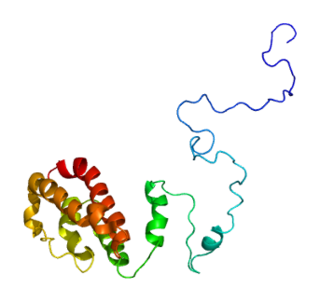
Fatty aldehyde dehydrogenase is an aldehyde dehydrogenase enzyme that in human is encoded in the ALDH3A2 gene on chromosome 17. Aldehyde dehydrogenase enzymes function to remove toxic aldehydes that are generated by the metabolism of alcohol and by lipid peroxidation.

Membrane-bound transcription factor site-1 protease, or site-1 protease (S1P) for short, also known as subtilisin/kexin-isozyme 1 (SKI-1), is an enzyme that in humans is encoded by the MBTPS1 gene. S1P cleaves the endoplasmic reticulum loop of sterol regulatory element-binding protein (SREBP) transcription factors.

Ephrin type-B receptor 2 is a protein that in humans is encoded by the EPHB2 gene.

AT-rich interactive domain-containing protein 3B is a protein that in humans is encoded by the ARID3B gene.

WD repeat-containing protein 8 is a protein that in humans is encoded by the WDR8 gene.

Sulfatase-modifying factor 2 is an enzyme that in humans is encoded by the SUMF2 gene.

Very long-chain acyl-CoA synthetase is an enzyme that in humans is encoded by the SLC27A2 gene.

Homeobox protein Hox-C11 is a protein that in humans is encoded by the HOXC11 gene.

Protein Red is a protein that in humans is encoded by the IK gene.

Angiomotin-like protein 1 is a protein that in humans is encoded by the AMOTL1 gene.

SH3 domain-binding glutamic acid-rich-like protein is a protein that in humans is encoded by the SH3BGRL gene.

SOX12 is a protein that in humans is encoded by the SOX12 gene. Sox12 belongs to the SoxC group of Sox family of transcription factors, together with Sox4 and Sox11. Sox12-null knockout mice appear normal, unlike Sox4 or Sox11 knockout mice. This probably comes from functional redundancy with Sox4 and Sox11. Sox12 is a weaker activator than both Sox4 and Sox11 in mouse.

Glutamate decarboxylase 2 is an enzyme that in humans is encoded by the GAD2 gene.

Thioredoxin reductase 1, cytoplasmic is an enzyme that in humans is encoded by the TXNRD1 gene.

PHD finger protein 1 is a protein that in humans is encoded by the PHF1 gene.

Putative tyrosine-protein phosphatase auxilin is an enzyme that in humans is encoded by the DNAJC6 gene.

Acid-sensing ion channel 4 (ASIC4) also known as amiloride-sensitive cation channel 4 (ACCN4) is a protein that in humans is encoded by the ASIC4 gene. The ASIC4 gene is one of the five paralogous genes that encode proteins that form trimeric acid-sensing ion channels (ASICs) in mammals. The cDNA of this gene was first cloned in 2000. The ASIC genes have splicing variants that encode different proteins that are called isoforms.

Calpain 6 is a protein in humans that is encoded by the CAPN6 gene.

ADP-ribosyltransferase 5 is a protein that in humans is encoded by the ART5 gene.

Solute carrier family 22 member 14 is a protein that in humans is encoded by the SLC22A14 gene.





















